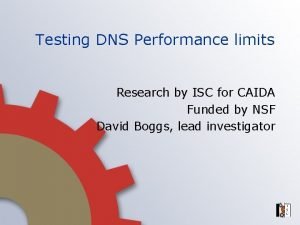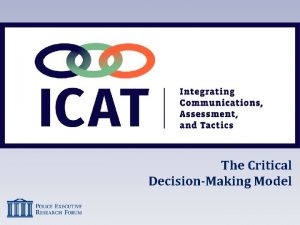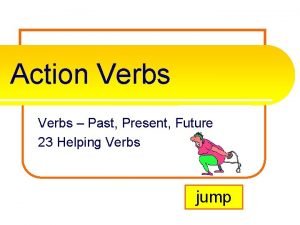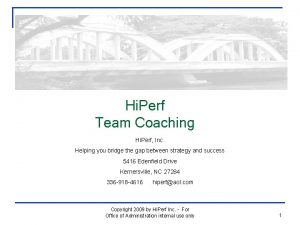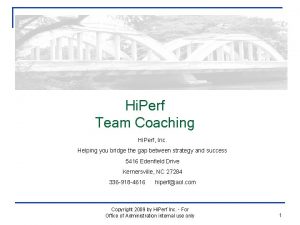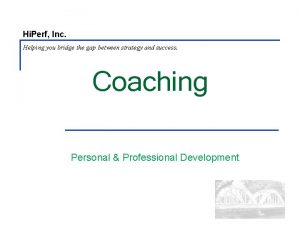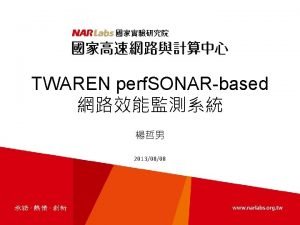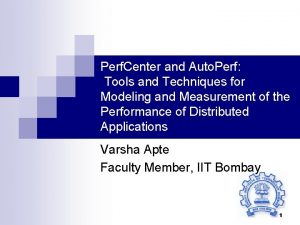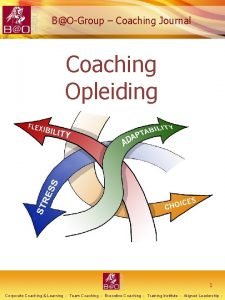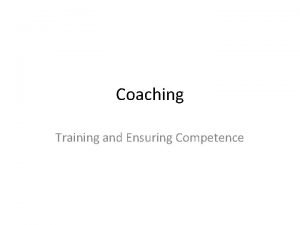Hi Perf Team Coaching Hi Perf Inc Helping












- Slides: 12

Hi. Perf Team Coaching Hi. Perf, Inc. Helping you bridge the gap between strategy and success 5416 Edenfield Drive Kernersville, NC 27284 336 -918 -4616 hiperf@aol. com Copyright 2009 by Hi. Perf Inc. - For Office of Finance internal use only 1

Copyright 2009 by Hi. Perf Inc. - For Office of Finance internal use only 2

Man e s i r erp ager Ent Group Passage Six ess in Bus ge a Man er Passage Five ger a Man Func Passage Four Manag tiona l Man ager Passage Three ers ag Man Passage Two age Othe rs e Self Manag Passage One Source: W. Mahler and S. Drotter Copyright 2009 by Hi. Perf Inc. - For Office of Finance internal use only 3

The Newmont Leadership Pipeline Leadership Transitions rprise Leading the Ente Leading a Group 6 5 usiness Leading a B 4 Leading Mu lti-Function s ction one Fun in s r e g a ding Man 3 Lea 2 Leading Others lf Managing Se Copyright 2009 by Hi. Perf Inc. - For Office of Finance internal use only 1 4

Transition Areas Time Application Where you spend your time Competencies (Proficiencies & Skills) Behaviors that describe excellent performance in a particular work context Focus (Work Values) What you pay attention to, value, and place importance on “What Made You Successful In The Past, May Hold You Back In The Future” Copyright 2009 by Hi. Perf Inc. - For Office of Finance internal use only 5

Leadership Transitions Transition # 1 2 3 4 5 6 Biggest Change(s) from previous role Getting work done thru others (first line supervisors) Selecting & developing future leaders (talent developers) Valuing unfamiliar areas, developing into proficient functional strategists, team play with other functional managers, higher level communication and delegation skills Developing a profit perspective, valuing & integrating functions, reflection and analysis, working with a wider breadth and scope of people, short term profit, long term success Evaluating strategy for capital allocation and deployment purposes, developing business managers, developing & implementing a portfolio strategy Develop long-term visionary thinking, value focus rather than skill focus, external sensitivity, managing external constituencies, assembling a high performing executive team of direct reports Copyright 2009 by Hi. Perf Inc. - For Office of Finance internal use only 6

Transition Areas 1 - Lead Others 2 - Lead Managers 3 – Lead a Function Learning to value leadership work rather than just tolerate it; they must believe that making time for others, planning and coaching are necessary tasks and their responsibility; relationship building with their boss, direct reports, and customers Developing and coaching first line managers Short and long term strategic vision, learning to value areas outside their own experience Planning work, job design, delegation, problem solving, motivating, coaching, performance measurement, and relationship building Selecting people to transition through assigning managerial and leadership work to them, measuring progress as managers and coaching them; focus on strategic issues that support the overall business and deploy and redeploy resources among units Leadership maturity, empathy, business judgment, listen and seek information from inside and outside the organization, think in short and long term strategic directions and goals New timeframes that govern how one works Set priorities, maintain balance between completing own work and helping others perform effectively; being available and approachable to direct reports Selecting and training first-line managers, holding managers accountable for managerial work, and tearing down silos between teams or groups Participation in business team meetings and working with other functional managers; strong delegation skills of functional tasks to direct reports Common Pitfalls: • Common signs of struggle with leadership transition • Focus: What people believe is important and so become the focus of their efforts Competencies: The new capabilities required to execute new responsibilities Time Applications: • Unable to shift from doing the work to getting work done through others Fixes mistakes or competes with direct reports on assignments rather than teaching them to do the work properly Views questions from their reports as interruptions • • • Hold first line-managers accountable for technical work rather than managerial work Difficulty delegating Poor performance management Failure to build a strong team Chooses clones over contributors Lack of interest in strategic issues Copyright 2009 by Hi. Perf Inc. - For Office of Finance internal use only • • • Failure to make the transition from an operational project orientation to a strategic one Inability to manage and value work that is unfamiliar or of relatively little interest Immaturity as a leader-manager 7

4 – Lead a Business 5 – Lead a Group 6 – Lead the Enterprise Changes mindset from a functional perspective (“Can we do it? ”) to a profit perspective (Should we do this? ); value both short-term results and long-term business planning Values other’s success and gains satisfaction in developing the organization beyond personal success Focuses on a few but significant strategic decisions or initiatives; change in self-concept as a leader of an enterprise Develop business strategy; make trade-off decisions and integrate the plans and programs of diverse functions into one effective business plan; develop business strategies; business acumen Evaluate business strategy to determine which business the Group should be in and which to exit; build programs that will produce functional managers who can grow to general managers; must be “maze-bright” and able to effectively interact with each segment organization; community, industry, governmental and ceremonial activities Setting direction, assuring the enterprise can execute the strategy, building the social architecture, connecting the enterprise with key external stakeholders such as governments, shareholders, Wall Street, customer organizations New timeframes that govern how one works Moves easily from the here and now to three-years out and back again; spends time working with functions perhaps not understood or valued in the past Same as business manager but time spans are longer, decisions are bigger, and uncertainties and risks are greater Makes decisions in the context of long-term policy implications Common Pitfalls: • Common signs of struggle with leadership transition • Transition Areas Focus: What people believe is important and so become the focus of their efforts Competencies: The new capabilities required to execute new responsibilities Time Applications: • • Uninspired communication Inability to assemble a strong team Failure to grasp how the business can make money Problems with time management Neglect of people issues Avoids conflict • • Acting like business General Manager rather than Group Executive Maintaining an adversarial relationship with the organization Ignoring the uncovered Passing up Business Manager development opportunities Copyright 2009 by Hi. Perf Inc. - For Office of Finance internal use only • • Lack of understanding for how the company gets things done Majority of time is spent on external relationships Not devoting enough time to the soft side of the business Board members keep asking them the same questions 8

Survey Data A Recent Survey* Asked Leaders Who had Transitioned Roles in the Prior 12 Months: What would they have done differently? • Moved more quickly • Been stronger with direct reports (assessing team, setting clear expectations, holding others accountable) • Created & implemented a transition plan • Set a clearer agenda • Focused more on relationships and key stakeholders • Survey conducted by Macquarie Graduate • School of Management Copyright 2009 by Hi. Perf Inc. - For Office of Finance internal use only 9

Transition Analysis Area Focus Competencies Time Have (what, how & when you will use? ) Need (what, how will you acquire and when will you use? ) Transition (what, how will you transition & when? ) Copyright 2009 by Hi. Perf Inc. - For Office of Finance internal use only 10

Next Steps n What? n So What? n Now What? Copyright 2009 by Hi. Perf Inc. - For Office of Finance internal use only 11

Copyright 2009 by Hi. Perf Inc. - For Office of Finance internal use only 12
 All 23 linking verbs
All 23 linking verbs Dns perf test
Dns perf test Perf rmans
Perf rmans Perf internet
Perf internet Critical decision-making model
Critical decision-making model Perf expert
Perf expert The white team cheers for the blue team, just like
The white team cheers for the blue team, just like Bureaucratic bypass syndrome
Bureaucratic bypass syndrome Team spirit becomes team infatuation
Team spirit becomes team infatuation Issues and ethics in the helping professions 9th edition
Issues and ethics in the helping professions 9th edition Helping verbs past present future
Helping verbs past present future Text tula about helping others
Text tula about helping others Helping hippos
Helping hippos

